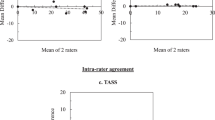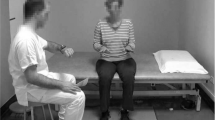Abstract
Study design
Observational, comparative, and transversal study.
Objective
To identify the cut-off points in the Trunk Control Test (TCT) for individuals with Spinal Cord Injury (SCI) to determine the ability to perform independently the different activities of daily living (ADL) according to the Spinal Cord Independence Measure-III (SCIM-III).
Setting
National Institute of Rehabilitation, Mexico City.
Methods
Individuals with SCI of any neurologic level and severity according to ISNCSCI, in sub-acute and chronic phases were included. Receiver Operating Characteristic (ROC) curves were made to identify the cut-off points on the TCT that discriminate the individuals that can independently perform each of the ADL described in the SCIM-III.
Results
A total of 604 participants were evaluated, 70.7% male; mean age of 34 (± 14) years; time since injury was 134 ± 360 days; predominating motor complete injury (50.1%). It was demonstrated through ROC curves, that there are different cut-off points in the TCT that are sensitive and specific to discriminate individuals that can independently perform the majority of the items of the SCIM-III of those who perform it with assistance. Domains that do not depend on an adequate trunk control (respiration and sphincter management) had poor areas under the curve, with low sensitivity and specificity.
Conclusions
The application of the TCT in individuals with SCI allows to discriminate between individuals who perform the different ADL independently of those who do not, at this subject institute. These results can guide the management of individuals with SCI, helping to establish short term goals.
This is a preview of subscription content, access via your institution
Access options
Subscribe to this journal
Receive 12 print issues and online access
$259.00 per year
only $21.58 per issue
Buy this article
- Purchase on Springer Link
- Instant access to full article PDF
Prices may be subject to local taxes which are calculated during checkout



Similar content being viewed by others
Data availability
The data generated or analyzed during this study are available from the corresponding author on reasonable request.
References
Macpherson JM, Fung J, Jacobs R. Postural orientation, equilibrium, and the spinal cord. Adv Neurol. 1997;72:227-32.
Reft J, Hasan Z. Trajectories of target reaching arm movements in individuals with spinal cord injury: E€ect of external trunk support. Spinal Cord [Internet]. 2002;40:186–91. https://doi.org/10.1038/sj/sc/3101277.
Anderson K, Aito S, Atkins M, Biering-Sørensen F, Charlifue S, Curt A, et al. Functional recovery measures for spinal cord injury: an evidence-based review for clinical practice and research: Report of the National Institute on Disability and Rehabilitation Research Spinal Cord Injury Measures Meeting. J Spinal Cord Med. 2008;31:133–44.
Do MC, Bouisset S, Moynot C. Are paraplegics handicapped in the execution of a manual task? Ergonomics. 1985;28:1363–75. https://doi.org/10.1080/00140138508963252.
Janssen-Potten YJM, Seelen HAM, Drukker J, Reulen JPH. Chair configuration and balance control in persons with spinal cord injury. Arch Phys Med Rehabil. 2000;81:401–8. https://doi.org/10.1053/mr.2000.3859.
Edgerton V, de Leon R, Karkema S, Hodgson J, London N, Reinkensmeyer D, et al. Retraining the injured spinal cord. J Physiol. 2001;533:15–20.
Wade DT. Goal setting in rehabilitation: An overview of what, why and how. Clin Rehabil. 2009;23:291–5. https://doi.org/10.1177/0269215509103551.
Maribo T, Jensen CM, Madsen LS, Handberg C. Experiences with and perspectives on goal setting in spinal cord injury rehabilitation: a systematic review of qualitative studies. Spinal Cord. 2020;58:949–58. https://doi.org/10.1038/s41393-020-0485-8.
Consortium for Spinal Cord Medicine. Outcomes following traumatic spinal cord injury: clinical practice guidelines for health-care professionals. J Spinal Cord Med. 2000;23:289–289. https://doi.org/10.1080/10790268.2000.11753539.
Kobayashi S, Miyata K, Tamura S, Takeda R, Iwamoto H. Cut-off values and sub-items of the Berg Balance Scale for walking-aid use in hospitalized older adults with a hip fracture: a retrospective analysis. Physiother Theory Pract. 2022. https://doi.org/10.1080/09593985.2022.2037114.
Ishiwatari M, Honaga K, Tanuma A, Takakura T, Hatori K, Kurosu A, et al. Trunk impairment as a predictor of activities of daily living in acute stroke. Front Neurol. 2021;12. https://doi.org/10.3389/fneur.2021.665592.
Quinzaños J, Villa AR, Flores AA, Pérez R. Proposal and validation of a clinical trunk control test in individuals with spinal cord injury. Spinal Cord. 2014;52:449–54. https://doi.org/10.1038/sc.2014.34.
Quinzaños-Fresnedo J, Fratini-Escobar PC, Almaguer-Benavides KM, Aguirre-Güemez AV, Barrera-Ortíz A, Pérez-Zavala R, et al. Prognostic validity of a clinical trunk control test for independence and walking in individuals with spinal cord injury. J Spinal Cord Med. 2020;43:331–8. https://doi.org/10.1080/10790268.2018.1518124.
Swets JA. Measuring the accuracy of diagnostic systems. Sci (1979) [Internet]. 1988;240:1285–93. https://doi.org/10.1126/science.3287615.
Rupp R, Biering-Sørensen F, Burns SP, Graves DE, Guest J, Jones L, et al. International standards for neurological classification of spinal cord injury. Top Spinal Cord Inj Rehabil. Thomas Land Publishers Inc.; 2021.
Catz A, Itzkovich M, Steinberg F, Philo O, Ring H, Ronen J, et al. The Catz-Itzkovich SCIM: A revised version of the spinal cord independence measure. Disabil Rehabil. 2001;23:263–8. https://doi.org/10.1080/096382801750110919.
van Middendorp JJ, Hosman AJF, Donders ART, Pouw MH, Ditunno JFJ, Curt A, et al. A clinical prediction rule for ambulation outcomes after traumatic spinal cord injury: a longitudinal cohort study. Lancet [Internet]. 2011;377:1004–10. https://doi.org/10.1016/S0140-6736(10)62276-3.
Nas K, Yazmalar L, Şah V, Aydin A, Öneş K. Rehabilitation of spinal cord injuries. World J Orthop. 2015;6:8–16. https://doi.org/10.5312/wjo.v6.i1.8.
Duarte E, Marco E, Muniesa JM, Belmonte R, Diaz P, Tejero M, et al. Trunk control test as a functional predictor in stroke patients. J Rehabil Med. 2002;34:267–72.
Stevenson TJ. Detecting change in patients with stroke using the Berg Balance Scale. Aust J Physiother. 2001;47:29–38. https://doi.org/10.1016/s0004-9514(14)60296-8.
Russell D, Avery L, Rosenbaum P, Raina P, Walter S, Palisano R. Improved scaling of the gross motor function measure for children with cerebral palsy: evidence of reliability and validity. Phys Ther [Internet]. 2000;80:873–85.
National Spinal Cord Injury Statistical Center. The 2017 annual statistical report for the spinal cord injury model systems. 2018.
Birmingham A. National Spinal Cord Injury Statistical Center, Facts and Figures at a Glance [Internet]. 2021. Available from: www.msktc.org/sci/model-system-centers.
Author information
Authors and Affiliations
Contributions
JQF: Protocol design. Statistical Analysis. Recruitment and evaluation. Interpretation of results. Article Writing. RCJ: Recruiting and clinical evaluation. Article revision. DQL: Recruiting and clinical evaluation. Article revision. MRB: Recruiting and clinical evaluation. Article writing and revision. Interpretation of results. ABO: Recruiting and clinical evaluation. Article revision. AAG: Recruiting and clinical evaluation. Article revision.
Corresponding author
Ethics declarations
Competing interests
The authors declare no competing interests.
Ethical approval
The study has been approved by the local institutional review board.
Additional information
Publisher’s note Springer Nature remains neutral with regard to jurisdictional claims in published maps and institutional affiliations.
Part of the material of the manuscript was presented at the American Spinal Injury Association Meeting 2022 in New Orleans, may the 20th 2022.
Rights and permissions
Springer Nature or its licensor (e.g. a society or other partner) holds exclusive rights to this article under a publishing agreement with the author(s) or other rightsholder(s); author self-archiving of the accepted manuscript version of this article is solely governed by the terms of such publishing agreement and applicable law.
About this article
Cite this article
Quinzaños-Fresnedo, J., Contreras-Juvenal, R., Quezada-López, D.C. et al. Determination of cut-off points in the Trunk control test for spinal cord injury to assess the ability to perform different activities of daily living. Spinal Cord 62, 12–16 (2024). https://doi.org/10.1038/s41393-023-00940-z
Received:
Revised:
Accepted:
Published:
Issue Date:
DOI: https://doi.org/10.1038/s41393-023-00940-z



